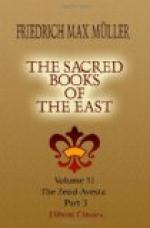To the idolatrous Arabs one of the most ancient universal objects of worship was that Black Stone, still kept in the building called Caabah at Mecca. Diodorus Siculus mentions this Caabah in a way not to be mistaken, as the oldest, most honored temple in his time; that is, some half-century before our Era. Silvestre de Sacy says there is some likelihood that the Black Stone is an aerolite. In that case, some man might see it fall out of Heaven! It stands now beside the Well Zemzem; the Caabah is built over both. A Well is in all places a beautiful affecting object, gushing out like life from the hard earth;—still more so in those hot dry countries, where it is the first condition of being. The Well Zemzem has its name from the bubbling sound of the waters, zem-zem; they think it is the Well which Hagar found with her little Ishmael in the wilderness: the aerolite and it have been sacred now, and had a Caabah over them, for thousands of years. A curious object, that Caabah! There it stands at this hour, in the black cloth-covering the Sultan sends it yearly; “twenty-seven cubits high;” with circuit, with double circuit of pillars, with festoon rows of lamps and quaint ornaments: the lamps will be lighted again this night—to glitter again under the stars. An authentic fragment of the oldest Past. It is the Keblah of all Moslem: from Delhi all onwards to Morocco, the eyes of innumerable praying men are turned towards it, five times, this day and all days: one of the notablest centres in the Habitation of Men.
It had been from the sacredness attached to this Caabah Stone and Hagar’s Well, from the pilgrimings of all tribes of Arabs thither, that Mecca took its rise as a Town. A great town once, though much decayed now. It has no natural advantage for a town; stands in a sandy hollow amid bare barren hills, at a distance from the sea; its provisions, its very bread, have to be imported. But so many pilgrims needed lodgings: and then all places of pilgrimage do, from the first, become places of trade. The first day pilgrims meet, merchants have also met: where men see themselves assembled for one object, they find that they can accomplish other objects which depend on meeting together. Mecca became the Fair of all Arabia. And thereby indeed the chief staple and warehouse of whatever Commerce there was between the Indian and the Western countries, Syria, Egypt, even Italy. It had at one time a population of 100,000; buyers, forwarders of those Eastern and Western products; importers for their own behoof of provisions and corn. The government was a kind of irregular aristocratic republic, not without a touch of theocracy. Ten Men of a chief tribe, chosen in some rough way, were Governors of Mecca, and Keepers of the Caabah. The Koreish were the chief tribe in Mohammed’s time; his own family was of that tribe. The rest of the Nation, fractioned and cut-asunder by deserts, lived




